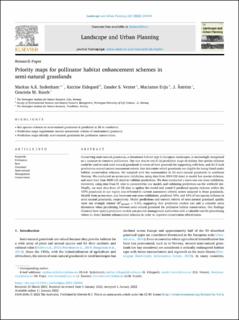| dc.contributor.author | Sydenham, Markus A. K. | |
| dc.contributor.author | Eldegard, Katrine | |
| dc.contributor.author | Venter, Zander | |
| dc.contributor.author | Evju, Marianne | |
| dc.contributor.author | Åström, Jens | |
| dc.contributor.author | Rusch, Graciela | |
| dc.date.accessioned | 2022-06-28T07:43:40Z | |
| dc.date.available | 2022-06-28T07:43:40Z | |
| dc.date.created | 2022-01-12T11:57:40Z | |
| dc.date.issued | 2022 | |
| dc.identifier.citation | Landscape and Urban Planning. 2022, 220. | en_US |
| dc.identifier.issn | 0169-2046 | |
| dc.identifier.uri | https://hdl.handle.net/11250/3001214 | |
| dc.description.abstract | Conserving semi-natural grasslands, a threatened habitat type in European landscapes, is increasingly recognized as a measure to conserve pollinators. Our aim was to test if (a) prediction maps of solitary bee species richness could be used to rank semi-natural grasslands in terms of their potential for supporting wild bees, and (b) if such predictions extend current assessment criteria that determine which grasslands are eligible for being listed under habitat conservation schemes. We sampled wild bee communities in 52 semi-natural grasslands in southeast Norway. We conducted an across-year validation, using data from 2019 (32 sites) to model bee species richness, and used data from 2020 (20 sites) to validate predictions. We then conducted a leave-one-out cross-validation, iteratively using data from 51 sites to parameterize our model, and validating predictions on the withheld site. Finally, we used data from all 52 sites to update the model and tested if predicted species richness within the 1075 grasslands in our region was reflected in current assessment criteria scores assigned to those grasslands. Models from across-year, and leave-one-out cross-validations, predicted 39%, and 43% of bee species richness in semi-natural grasslands, respectively. Model predictions and current criteria of semi-natural grassland quality were not strongly related (R2 adjusted = 0.01), suggesting that prediction models can add a valuable extra dimension when prioritizing between semi-natural grassland for pollinator habitat conservation. Our findings illustrate how spatial prediction models can provide management authorities with a valuable tool for prioritizing where to direct habitat enhancement schemes in order to improve conservation effectiveness. Pollinators Bees Grassland Semi-natural Management Conservation | |
| dc.language.iso | eng | en_US |
| dc.title | Priority maps for pollinator habitat enhancement schemes in semi-natural grasslands | en_US |
| dc.type | Journal article | en_US |
| dc.type | Peer reviewed | en_US |
| dc.description.version | publishedVersion | |
| dc.subject.nsi | VDP::Samfunnsgeografi: 290 | |
| dc.subject.nsi | VDP::Human geography: 290 | |
| dc.source.volume | 220 | en_US |
| dc.source.journal | Landscape and Urban Planning | en_US |
| dc.identifier.doi | 10.1016/j.landurbplan.2022.104354 | |
| dc.identifier.cristin | 1979318 | |
| dc.relation.project | Landbruksdirektoratet: Klima- og Miljøprogrammet:POLLILAND, grant number 2018/72806 | |
| cristin.ispublished | true | |
| cristin.fulltext | original | |
| cristin.qualitycode | 2 | |
